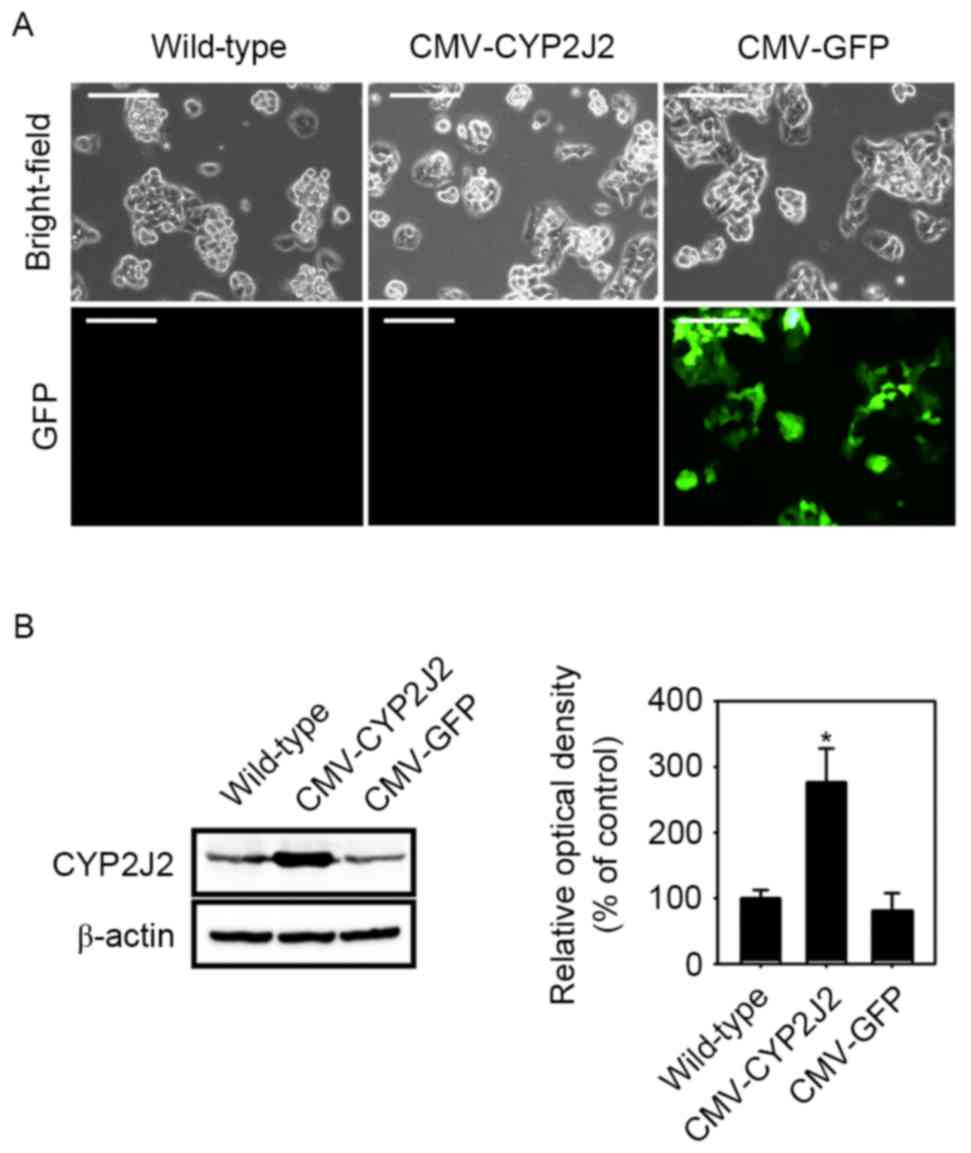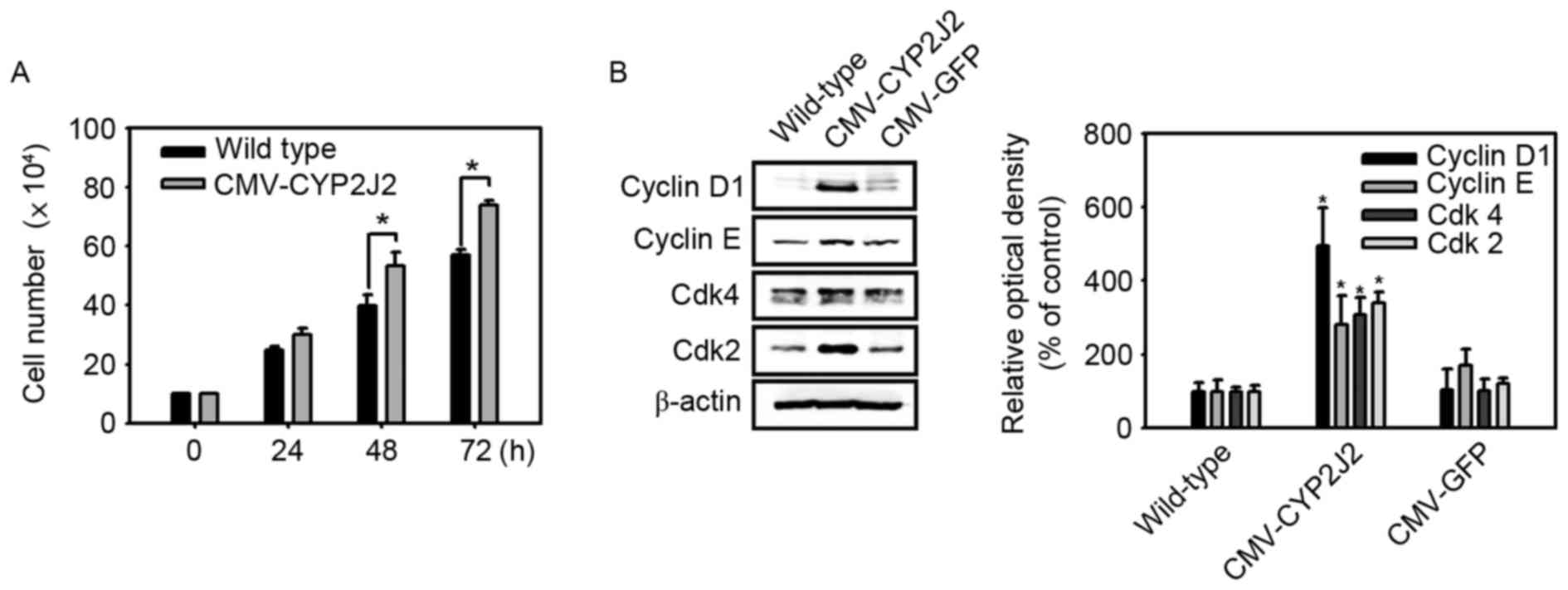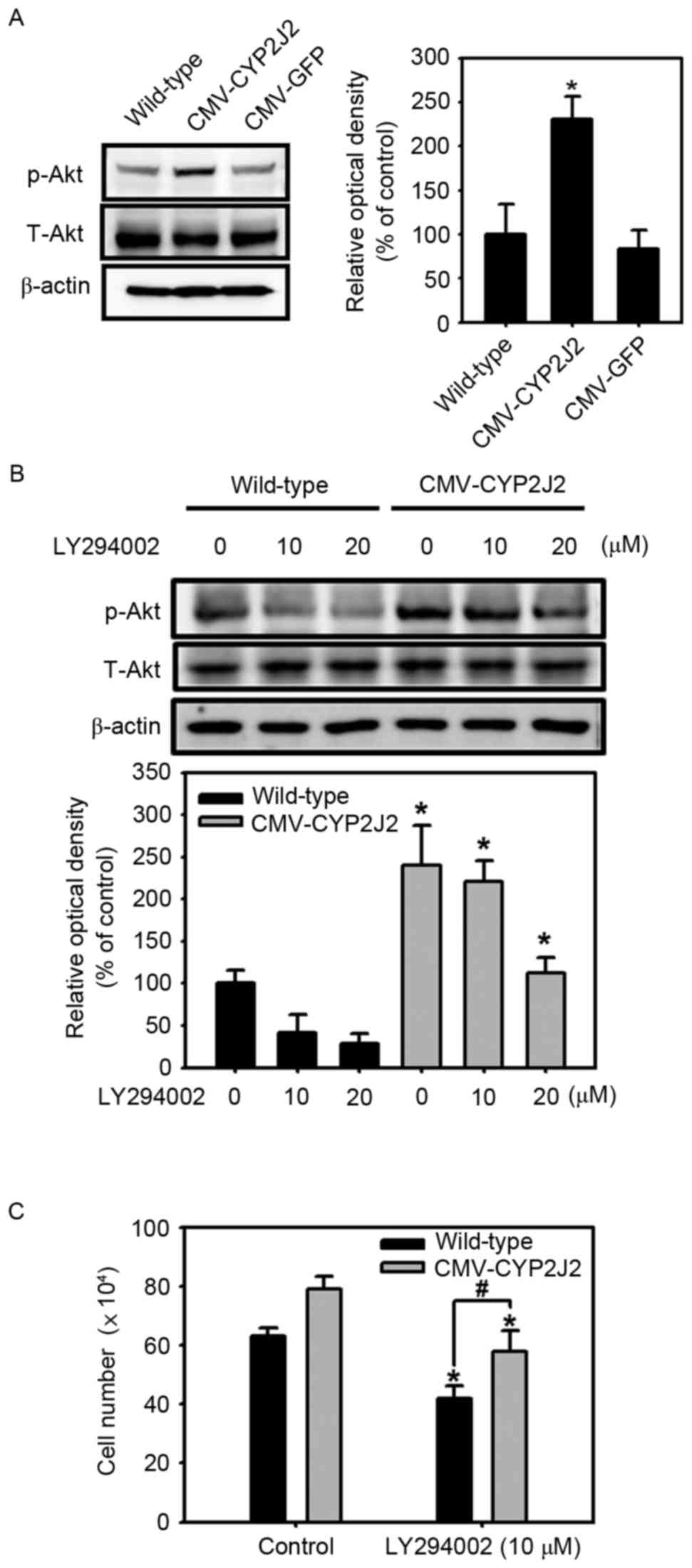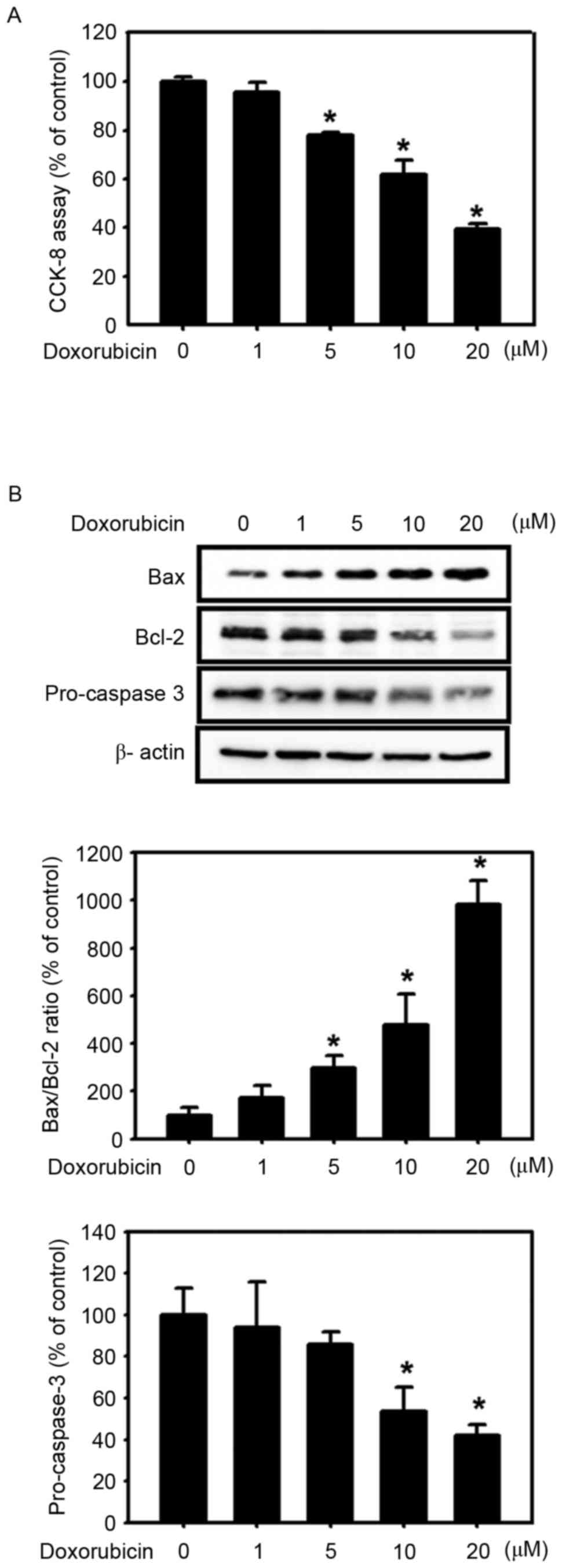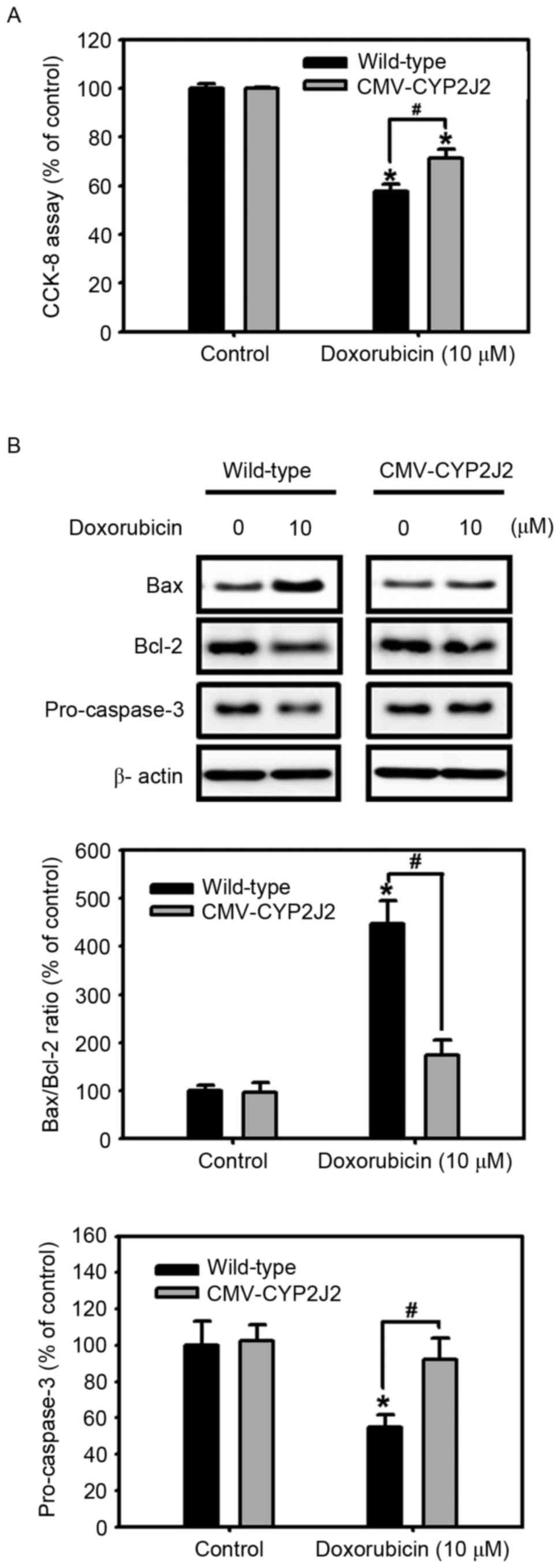Role of cytochrome P450 2J2 on cell proliferation and resistance to an anticancer agent in hepatocellular carcinoma HepG2 cells
- Authors:
- Published online on: August 28, 2017 https://doi.org/10.3892/ol.2017.6846
- Pages: 5484-5490
Abstract
Introduction
Human cytochrome P450 2J2 (CYP2J2) epoxygenase is an enzyme that metabolizes arachidonic acid and linoleic acid to four regioisomeric epoxyeicosatrienoic acids (EETs), namely 14,15-EET, 11,12-EET, 5,6-EET and 8,9-EET (1). This enzyme is widely expressed in multiple human tissues, including the liver, heart, lung, pancreas and bladder, and in endothelial cells (2–4). CYP2J2 and its metabolites exert numerous pathophysiological roles, including regulation of ion channel activity in cardiomyocytes (5), inhibition of inflammation (6), inhibition of apoptosis (7) and recovery of endothelial cells from hypoxic injury (8). CYP2J2 is also highly expressed in various cancer cell lines and tissues, including hepatocellular carcinoma (9). Elevated CYP2J2 messenger RNA and protein levels have been observed in diverse human cancer cell lines and human cancer tissues (9). Several studies have implicated CYP2J2 and its EET metabolites in the pathological development of human cancers, including solid tumors and hematological malignancies (10–12). Additionally, overexpression of CYP2J2 and elevated EET levels promote tumor malignancy, while the selective inhibition of CYP2J2 attenuates these effects (9,13). However, the precise role of CYP2J2 in hepatocellular carcinoma cells is still poorly understood.
Each year, hepatocellular carcinoma is diagnosed in >500,000 people worldwide (14). Liver cancer is the fifth most common cancer in men and the seventh in women (14). Although its incidence is highly variable in different geographic areas, hepatocellular carcinoma is one of the leading causes of mortality in the world, being among the most common cancers in both Eastern and Western countries (15). A more detailed understanding of the pathophysiological role of CYP2J2 may lead to the development of new therapeutic strategies to alter the pathogenesis of this disease (8,16).
Cancer cells often deregulate the cell cycle and undergo uncontrolled cell proliferation (17). Almost all anticancer chemotherapy strategies inhibit the proliferation of tumor cells by targeting cell cycle mechanisms to arrest cells and induce apoptosis (17,18). Additionally, the effectiveness of chemotherapy is limited by drug resistance (19). The present study investigated the potential role of CYP2J2 in cancer cell proliferation and drug resistance in hepatocellular carcinoma HepG2 cells. The results will provide a better understanding of the role of CYP2J2 in cancer and will help to develop more effective anticancer treatment strategies.
Materials and methods
Reagents
The HepG2 hepatocellular carcinoma cell line was purchased from the Korean Cell Line Bank (Seoul, Korea). HEK 293T cells were obtained from the American Type Culture Collection (Manassas, VA, USA). Cell Counting kit (CCK)-8 was purchased from Dojindo Molecular Technologies, Inc. (Kumamoto, Japan). X-tremeGENE HP DNA Transfection Reagent was acquired from Roche Applied Science (Penzberg, Germany). Human CYP2J2 complementary DNA (cDNA)-containing plasmid, Trypan blue solution (0.4%) and Pierce® ECL Western Blotting Substrate were acquired from Thermo Fisher Scientific, Inc. (Waltham, MA, USA), while Hyclone™ fetal bovine serum (FBS) was acquired from GE Healthcare Life Sciences (Logan, UT, USA). Anti-cyclin D1 (cat. no. sc-8396), anti-cyclin E (cat. no. sc-25303), anti-cyclin-dependent kinase (Cdk)2 (cat. no. sc-6248), anti-Cdk4 (cat. no. sc-749), anti-B-cell lymphoma (Bcl)-2 associated X protein (Bax) (cat. no. sc-493), anti-Bcl-2 (cat. no. sc-7382), anti-caspase-3 (cat. no. sc-373730), goat anti-rabbit immunoglobulin (Ig)G (cat. no. sc-2004) and goat anti-mouse IgG (cat. no. sc-2005) antibodies were supplied by Santa Cruz Biotechnology, Inc. (Dallas, TX, USA). Anti-phosphorylated-Akt (Ser473) (cat. no. 4060) and anti-total Akt (cat. no. 4691) antibodies were obtained from Cell Signaling Technology, Inc. (Danvers, MA, USA). Penicillin-Streptomycin Solution 100X, LY294002 and doxorubicin hydrochloride were obtained from Sigma-Aldrich (Merck KGaA, Darmstadt, Germany).
Cell culture
HepG2 cells were maintained in Dulbecco's modified Eagle's medium (DMEM) high glucose (4.5 g/l; Thermo Fisher Scientific Inc.), supplemented with 10% FBS and 1% Penicillin-Streptomycin Solution 100X, at 37°C in a humidified atmosphere (5% CO2). One day prior to the experiments, the cells were incubated with fresh DMEM without FBS.
Establishment of a CYP2J2-overexpressing stable HepG2 cell line
Lentiviral expression constructs containing cDNA encoding human CYP2J2 were generated. This transgene cassette employs the cytomegalovirus (CMV) immediate-early promoter (20). The lentiviral vector containing the puromycin resistance gene (CMV-eGFP-IRES-Puro plasmid) and the packaging vectors (VSV-G expressing envelop plasmid and another plasmid containing gag, pol and rev genes) were kindly provided by Dr. Yibing Qyang (Yale Cardiovascular Research Center, Yale School of Medicine, USA). In brief, the CMV-CYP2J2-IRES-Puro lentiviral vector was generated by substitution of eGFP sequence in CMV-eGFP-IRES-Puro plasmid with CYP2J2 sequence. CMV-CYP2J2 and control CMV-GFP viruses were generated by transfection of the lentiviral vectors (CMV-CYP2J2-IRES-Puro or CMV-eGFP-IRES-Puro plasmids) and packaging vectors into HEK 293T cells using X-tremeGene HP DNA transfection reagent (Roche Applied Science, Penzburg, Germany) at 37°C and 5% CO2 for 24 h. Virus-containing medium was collected every day for 3 days following transfection, and concentrated by ultracentrifugation at 55,200 × g and 4°C for 2 h (Hitachi, Ltd., Tokyo, Japan). HepG2 cells were exposed to concentrated virus-containing medium for 24 h at 37°C, followed by 2 days of culture in basal medium. Virus-infected cells were selected by treatment with puromycin (2 µg/ml) for 1 week. Images of each cell lines were obtained by fluorescence microscopy at magnification, ×200. (Leica DM IL LED Fluo; Leica Microsystems, Inc., Buffalo Grove, IL, USA).
Cell counting assay
Wild-type HepG2 cells, CMV-CYP2J2-transfected HepG2 cells and CMV-GFP-transfected HepG2 cells were plated at a density of 1×105 cells/35-mm dish and cultured at 37°C and 5% CO2. The number of viable cells was counted using the Trypan Blue exclusion method according to the protocol of the manufacturer, in triplicate for each group, at 24, 48 and 72 h after cell plating.
CCK-8 assay
A total of 5×103 wild-type HepG2 cells and CMV-CYP2J2-transfected HepG2 cells were cultured in 96-well plates (BD Biosciences, Franklin Lakes, NJ, USA). Following culture, the cells with or without doxorubicin for 24 h, the CCK-8 solution was then added to each well at 1:10 dilution, followed by further incubation at 37°C for 3 h. Absorbance was measured at 450 nm using a microplate reader (BioTek Instruments, Inc., Winooski, VT, USA).
Western blot analysis
Wild-type HepG2 cells, CMV-CYP2J2-transfected HepG2 cells or CMV-GFP-transfected HepG2 cells were cultured in the presence or absence of LY294002 for 8 h or doxorubicin for 24 h and the cells were directly lysed in culture dishes with radioimmunoprecipitation assay buffer (Boston BioProducts, Ashland, MA, USA) supplemented with a protease and phosphatase inhibitor cocktail mixture (cat. no. 88668; Thermo Fisher Scientific, Inc.). Cell lysates (20 µg) were separated using 10 or 12% SDS-PAGE and then transferred to polyvinylidene fluoride membranes (Merck KGaA). The blots were washed with TBS containing Tween-20 (TBST) [10 mM Tris-HCl (pH 7.6), 150 mM NaCl and 0.1% Tween-20], blocked with 5% skimmed milk in TBST for 1 h at room temperature and incubated for 12 h at 4°C with the primary antibodies at 1:1,000 dilution. Next, the membranes were washed with TBST and incubated with horseradish peroxidase-conjugated goat anti-rabbit or goat anti-mouse IgG antibodies (1:5,000 dilution) for 12 h at 4°C. The bands were visualized using Pierce® ECL Western Blotting Substrate (cat. no. 32209; Thermo Fisher Scientific, Inc.) according to the manufacturer's protocol. β-actin was used as an internal control.
Statistical analysis
All results are expressed as the mean ± standard error of the mean using SigmaPlot v11.0 software (Systat Software Inc., San Jose, CA, USA). Differences between two mean values were analyzed by the Student's t-test. P<0.05 was considered to indicate a statistically significant difference.
Results and Discussion
Effect of CYP2J2 overexpression on cell proliferation and cell cycle regulatory protein expression
To investigate the role of CYP2J2 on cell proliferation in HepG2 cells, stable HepG2 cell lines overexpressing CYP2J2 (CMV-CYP2J2) and GFP (CMV-GFP) were established using CMV-CYP2J2 or CMV-GFP lentiviruses, respectively. The expression levels of CYP2J2 protein in the stable cell lines were examined by western blot analysis. CMV-GFP virus was used as a positive control. CYP2J2 expression was significantly increased by infection with CMV-CYP2J2 virus in comparison with that observed in wild-type HepG2 cells (Fig. 1). To examine the effect of CYP2J2 on HepG2 cell proliferation, the numbers of wild-type and CMV-CYP2J2-transfected HepG2 cells in growth medium were counted at 24-h intervals. The rate of proliferation of CMV-CYP2J2-transfected HepG2 cells was significantly higher than that of wild-type HepG2 cells (Fig. 2A). The core of the molecular machinery that drives the cell cycle is the family of Cdks and their regulatory subunits, which are known as cyclins (21). Cdk-cyclin complexes are activated at precise points of the cell cycle through multiple levels of control, including complex assembly or expression levels (22). Therefore, the present study examined the expression levels of cyclin D1, cyclin E, Cdk2 and Cdk4 proteins. Cyclin D1, cyclin E, Cdk2 and Cdk4 expression was significantly increased by overexpression of CYP2J2 (Fig. 2B). These results suggest that overexpression of CYP2J2 promotes cell proliferation in HepG2 hepatocellular carcinoma cells through increased expression of cyclin D1, cyclin E, Cdk2 and Cdk4 proteins.
Involvement of the Akt signaling pathway in CYP2J2-induced cell proliferation
Akt is known to serve a central role in signaling pathways regulating tumor growth (23,24). The Akt signaling cascade is frequently dysregulated in multiple types of cancer and is implicated in tumor aggressiveness (23,24). Several reports indicated that Akt is activated by interaction with phosphatidylinositol (3–5)-trisphosphate [PtdIns(3,4,5) P3] via the pleckstrin homology domain (25,26). PtdIns (3,4,5)P3 is normally generated from phosphatidylinositol 4,5-bisphosphate by the enzyme phosphoinositide 3-kinase (PI3K) (27). Therefore, the present study investigated whether CYP2J2 regulates the activity of Akt, and the results revealed that Akt phosphorylation was significantly increased in CMV-CYP2J2-transfected HepG2 cells in comparison with that in wild-type and CMV-GFP-transfected HepG2 cells (Fig. 3A). To further confirm the role of CYP2J2 on the activity of Akt, the effect of a pharmacological inhibitor of PI3K, LY294002, was investigated in wild-type and CMV-CYP2J2-transfected HepG2 cell lines. As shown in Fig. 3B, wild-type and CMV-CYP2J2-transfected HepG2 cells were treated with different concentrations of LY294002 (0, 10 and 20 µM), and the results revealed that the phosphorylation of Akt was suppressed by LY294002 in both cell lines in a dose-dependent manner. However, the levels of Akt phosphorylation subsequent to LY294002 treatment were higher in CMV-CYP2J2-transfected HepG2 cells than in wild-type HepG2 cells (Fig. 3B). The present study also determined how the above PI3K inhibitor, LY294002, affects the proliferation of CMV-CYP2J2-transfected HepG2 cells, and it was observed that the enhanced cell proliferation in CMV-CYP2J2-transfected HepG2 cells in the absence of LY294002 (10 µM) was significantly inhibited in the presence of LY294002 (Fig. 3C). These results suggest that overexpression of CYP2J2 enhances the activity of Akt, and that CYP2J2-mediated cell proliferation is PI3K/Akt signaling-dependent.
Effect of CYP2J2 overexpression on resistance to an anticancer agent
To investigate whether overexpression of CYP2J2 affects resistance to an anticancer agent, the present study subsequently examined cell viability in the presence of doxorubicin using the CCK-8 assay. Doxorubicin (adriamycin), an anticancer agent used in the treatment of advanced hepatocellular carcinoma due to its antitumor action (28), induces apoptotic cell death in various types of cells, including cancer cells (29). Doxorubicin reduced significantly the cell viability of wild-type HepG2 cells in a dose-dependent manner (0–20 µM; Fig. 4A). To examine whether the apoptotic pathway is involved in doxorubicin-induced cytotoxicity in HepG2 cells, the expression levels of apoptosis-associated proteins, including Bax, Bcl-2 and pro-caspase-3, were analyzed. Incubation of wild-type HepG2 cells with doxorubicin (0–20 µM) for 24 h increased the expression of Bax, decreased the expression of Bcl-2, enhanced the Bax/Bcl-2 ratio and diminished the expression levels of pro-caspase-3 in a dose-dependent manner (Fig. 4B). These results suggest that doxorubicin-induced cytotoxicity is mediated by the apoptotic pathway. Inhibition of apoptosis is generally considered to be a major determinant of resistance to chemotherapy (29). To compare the cytotoxic effect of doxorubicin in wild-type and CMV-CYP2J2-transfected HepG2 cells, these cell lines were treated with 10 µM doxorubicin for 24 h, and cell viability was determined using the CCK-8 assay. As shown in Fig. 5A, doxorubicin significantly decreased cell viability in both cell lines. Notably, the doxorubicin-induced reduction of cell viability was significantly attenuated in CMV-CYP2J2-transfected HepG2 cells compared with that in wild-type HepG2 cells. Additionally, doxorubicin induced a significant increase in the Bax/Bcl-2 ratio and decreased pro-caspase-3 levels in both cell lines; however, the increase in the Bax/Bcl-2 ratio and the decrease in pro-caspase-3 levels were inhibited in CMV-CYP2J2-transfected HepG2 cells in comparison with those in wild-type HepG2 cells. These results suggest that the cytotoxic effect of doxorubicin is significantly attenuated by CYP2J2 overexpression; in other words, CYP2J2 overexpression confers resistance to doxorubicin in HepG2 cells.
In conclusion, the present study has demonstrated that CYP2J2 promotes cell proliferation and drug resistance to an anticancer agent in HepG2 cells. CYP2J2-mediated cell proliferation requires the activity of Akt, which is known to be frequently dysregulated in numerous types of cancer (24). Additionally, overexpression of CYP2J2 decreased the apoptotic cell death caused by the above anticancer agent. Robust cell proliferative capacity and resistance to anticancer agents are major hurdles to the development of efficient chemotherapy, and abnormal cell proliferation and apoptotic cell death have been extensively studied to identify potential therapeutic targets against human cancer (30). Various cellular components, including hypoxia-inducible factor-1α (31), transducin β-like protein 1-related protein (32) and fibroblast growth factor receptor 4 (33), have been shown to contribute to cancer cell proliferation, and due to their anti-apoptotic properties, they have been studied as putative targets for cancer therapy (31–33). The results of the present study revealed that CYP2J2 also serves important roles in inducing cell proliferation and inhibiting the cell death induced by anticancer agents. Therefore, CYP2J2 can be a potential target to reduce cancer cell proliferation and resistance to chemotherapy.
Acknowledgements
The present study was supported by the National Research Foundation, which is funded by the Ministry of Education of the Korean Government (grant no. 2014R1A1A2056042; NRF-2016R1D1A1A02936940), and by the Ministry of Science, Information Communication Technology and Future Planning of the Korean Government (grant no. 2012R1A4A1028835).
References
|
Capdevila JH, Falck JR and Harris RC: Cytochrome P450 and arachidonic acid bioactivation. Molecular and functional properties of the arachidonate monooxygenase. J Lipid Res. 41:163–181. 2000.PubMed/NCBI | |
|
Enayetallah AE, French RA, Thibodeau MS and Grant DF: Distribution of soluble epoxide hydrolase and of cytochrome P450 2C8, 2C9 and 2J2 in human tissues. J Histochem Cytochem. 52:447–454. 2004. View Article : Google Scholar : PubMed/NCBI | |
|
Fisslthaler B, Popp R, Kiss L, Potente M, Harder DR, Fleming I and Busse R: Cytochrome P450 2C is an EDHF synthase in coronary arteries. Nature. 401:493–497. 1999. View Article : Google Scholar : PubMed/NCBI | |
|
Rosolowsky M and Campbell WB: Synthesis of hydroxyeicosatetraenoic (HETEs) and epoxyeicosatrienoic acids (EETs) by cultured bovine coronary artery endothelial cells. Biochim Biophys Acta. 1299:267–277. 1996. View Article : Google Scholar : PubMed/NCBI | |
|
Lee HC, Lu T, Weintraub NL, VanRollins M, Spector AA and Shibata EF: Effects of epoxyeicosatrienoic acids on the cardiac sodium channels in isolated rat ventricular myocytes. J Physiol. 1:153–168. 1999. View Article : Google Scholar | |
|
Node K, Huo Y, Ruan X, Yang B, Spiecker M, Ley K, Zeldin DC and Liao JK: Anti-inflammatory properties of cytochrome P450 epoxygenase-derived eicosanoids. Science. 285:1276–1279. 1999. View Article : Google Scholar : PubMed/NCBI | |
|
Chen JK, Capdevila J and Harris RC: Cytochrome p450 epoxygenase metabolism of arachidonic acid inhibits apoptosis. Mol Cell Biol. 21:6322–6331. 2001. View Article : Google Scholar : PubMed/NCBI | |
|
Yang B, Graham L, Dikalov S, Mason RP, Falck JR, Liao JK and Zeldin DC: Overexpression of cytochrome P450 CYP2J2 protects against hypoxia-reoxygenation injury in cultured bovine aortic endothelial cells. Mol Pharmacol. 60:310–320. 2001.PubMed/NCBI | |
|
Jiang JG, Chen CL, Card JW, Yang S, Chen JX, Fu XN, Ning YG, Xiao X, Zeldin DC and Wang DW: Cytochrome P450 2J2 promotes the neoplastic phenotype of carcinoma cells and is up-regulated in human tumors. Cancer Res. 65:4707–4715. 2005. View Article : Google Scholar : PubMed/NCBI | |
|
Huang SM, Mishina YM, Liu S, Cheung A, Stegmeier F, Michaud GA, Charlat O, Wiellette E, Zhang Y, Wiessner S, et al: Tankyrase inhibition stabilizes axin and antagonizes Wnt signalling. Nature. 461:614–620. 2009. View Article : Google Scholar : PubMed/NCBI | |
|
Chen C, Wei X, Rao X, Wu J, Yang S, Chen F, Ma D, Zhou J, Dackor RT, Zeldin DC and Wang DW: Cytochrome P450 2J2 is highly expressed in hematologic malignant diseases and promotes tumor cell growth. J Pharmacol Exp Ther. 336:344–355. 2011. View Article : Google Scholar : PubMed/NCBI | |
|
Freedman RS, Wang E, Voiculescu S, Patenia R, Bassett RL Jr, Deavers M, Marincola FM, Yang P and Newman RA: Comparative analysis of peritoneum and tumor eicosanoids and pathways in advanced ovarian cancer. Clin Cancer Res. 13:5736–5744. 2007. View Article : Google Scholar : PubMed/NCBI | |
|
Jiang JG, Ning YG, Chen C, Ma D, Liu ZJ, Yang S, Zhou J, Xiao X, Zhang XA, Edin ML, et al: Cytochrome p450 epoxygenase promotes human cancer metastasis. Cancer Res. 67:6665–6674. 2007. View Article : Google Scholar : PubMed/NCBI | |
|
El-Serag HB: Hepatocellular carcinoma. N Engl J Med. 365:1118–1127. 2011. View Article : Google Scholar : PubMed/NCBI | |
|
Critelli RM, De Maria N and Villa E: Biology of Hepatocellular Carcinoma. Dig Dis. 33:635–641. 2015. View Article : Google Scholar : PubMed/NCBI | |
|
Kroetz DL and Zeldin DC: Cytochrome P450 pathways of arachidonic acid metabolism. Curr Opin Lipidol. 13:273–283. 2002. View Article : Google Scholar : PubMed/NCBI | |
|
Manchado E, Guillamot M and Malumbres M: Killing cells by targeting mitosis. Cell Death Differ. 19:369–377. 2012. View Article : Google Scholar : PubMed/NCBI | |
|
Williams GH and Stoeber K: The cell cycle and cancer. J Pathol. 226:352–364. 2012. View Article : Google Scholar : PubMed/NCBI | |
|
Holohan C, Van Schaeybroeck S, Longley DB and Johnston PG: Cancer drug resistance: An evolving paradigm. Nat Rev Cancer. 13:714–726. 2013. View Article : Google Scholar : PubMed/NCBI | |
|
Gruh I, Wunderlich S, Winkler M, Schwanke K, Heinke J, Blömer U, Ruhparwar A, Rohde B, Li RK, Haverich A and Martin U: Human CMV immediate-early enhancer: A useful tool to enhance cell-type-specific expression from lentiviral vectors. J Gene Med. 10:21–32. 2008. View Article : Google Scholar : PubMed/NCBI | |
|
Stead E, White J, Faast R, Conn S, Goldstone S, Rathjen J, Dhingra U, Rathjen P, Walker D and Dalton S: Pluripotent cell division cycles are driven by ectopic Cdk2, cyclin A/E and E2F activities. Oncogene. 21:8320–8333. 2002. View Article : Google Scholar : PubMed/NCBI | |
|
Lee MY, Lim HW, Lee SH and Han HJ: Smad, PI3K/Akt and Wnt-dependent signaling pathways are involved in BMP-4-induced ESC self-renewal. Stem Cells. 27:1858–1868. 2009. View Article : Google Scholar : PubMed/NCBI | |
|
Altomare DA and Testa JR: Perturbations of the AKT signaling pathway in human cancer. Oncogene. 24:7455–7464. 2005. View Article : Google Scholar : PubMed/NCBI | |
|
Mitsiades CS, Mitsiades N and Koutsilieris M: The Akt pathway: Molecular targets for anti-cancer drug development. Curr Cancer Drug Targets. 4:235–256. 2004. View Article : Google Scholar : PubMed/NCBI | |
|
Joh EH, Hollenbaugh JA, Kim B and Kim DH: Pleckstrin homology domain of Akt kinase: A proof of principle for highly specific and effective non-enzymatic anti-cancer target. PLoS One. 7:e504242012. View Article : Google Scholar : PubMed/NCBI | |
|
Milburn CC, Deak M, Kelly SM, Price NC, Alessi DR and Van Aalten DM: Binding of phosphatidylinositol 3,4,5-trisphosphate to the pleckstrin homology domain of protein kinase B induces a conformational change. Biochem J. 375:531–538. 2003. View Article : Google Scholar : PubMed/NCBI | |
|
Song G, Ouyang G and Bao S: The activation of Akt/PKB signaling pathway and cell survival. J Cell Mol Med. 9:59–71. 2005. View Article : Google Scholar : PubMed/NCBI | |
|
Yeo W, Mok TS, Zee B, Leung TW, Lai PB, Lau WY, Koh J, Mo FK, Yu SC, Chan AT, et al: A randomized phase III study of doxorubicin versus cisplatin/interferon alpha-2b/doxorubicin/fluorouracil (PIAF) combination chemotherapy for unresectable hepatocellular carcinoma. J Natl Cancer Inst. 97:1532–1538. 2005. View Article : Google Scholar : PubMed/NCBI | |
|
Rebbaa A, Zheng X, Chou PM and Mirkin BL: Caspase inhibition switches doxorubicin-induced apoptosis to senescence. Oncogene. 22:2805–2811. 2003. View Article : Google Scholar : PubMed/NCBI | |
|
Evan GI and Vousden KH: Proliferation, cell cycle and apoptosis in cancer. Nature. 411:342–348. 2001. View Article : Google Scholar : PubMed/NCBI | |
|
Takasaki C, Kobayashi M, Ishibashi H, Akashi T and Okubo K: Expression of hypoxia-inducible factor-1α affects tumor proliferation and antiapoptosis in surgically resected lung cancer. Mol Clin Oncol. 5:295–300. 2016. View Article : Google Scholar : PubMed/NCBI | |
|
Guo Y, Wang J, Zhang L, Shen S, Guo R, Yang Y, Chen W, Wang Y, Chen G and Shuai X: Theranostical nanosystem-mediated identification of an oncogene and highly effective therapy in hepatocellular carcinoma. Hepatology. 63:1240–1255. 2016. View Article : Google Scholar : PubMed/NCBI | |
|
Ye YW, Zhou Y, Yuan L, Wang CM, Du CY, Zhou XY, Zheng BQ, Cao X, Sun MH, Fu H and Shi YQ: Fibroblast growth factor receptor 4 regulates proliferation and antiapoptosis during gastric cancer progression. Cancer. 117:5304–5313. 2011. View Article : Google Scholar : PubMed/NCBI |



